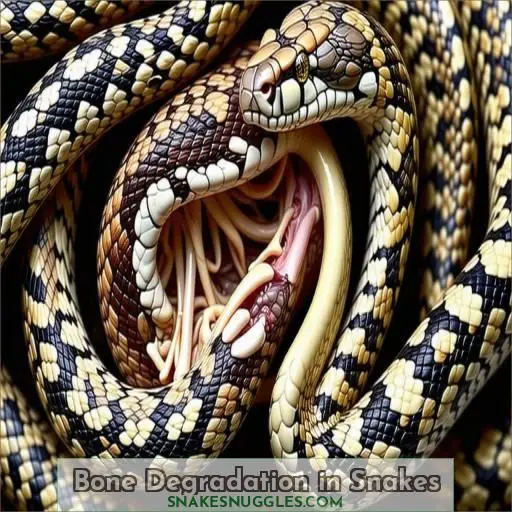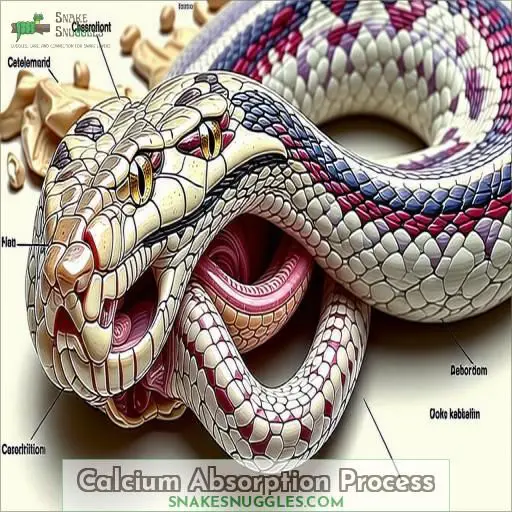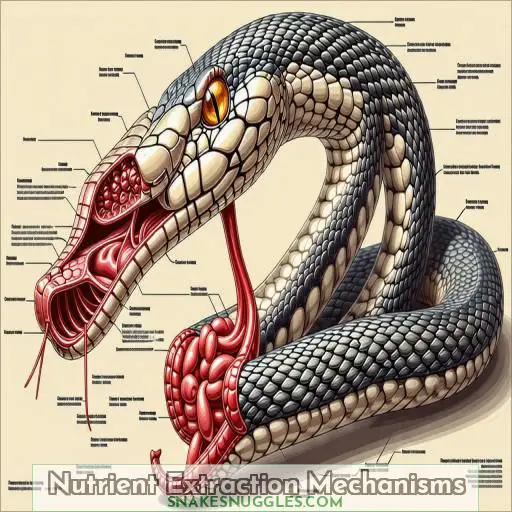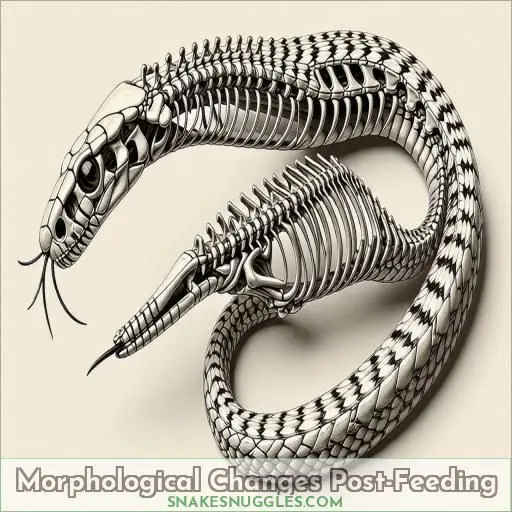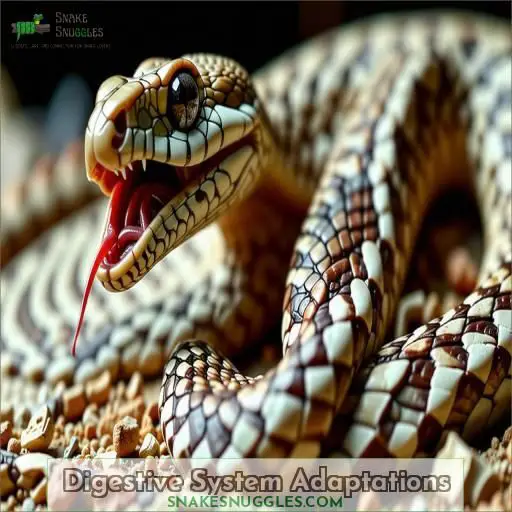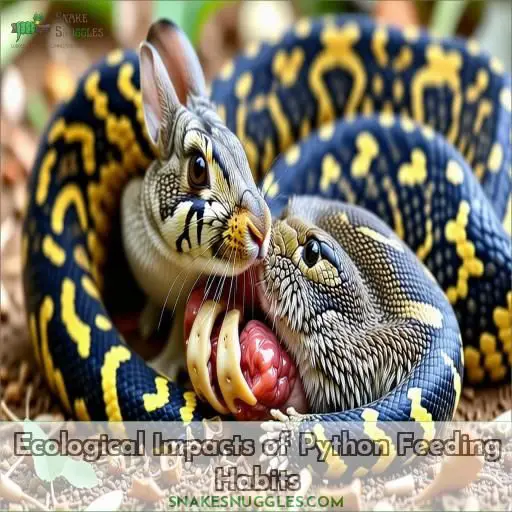This site is supported by our readers. We may earn a commission, at no cost to you, if you purchase through links.

This process is facilitated by specialized cells in your small intestine.
These golf tee-shaped cells use digestive enzymes and gastric juices to degrade bone particles, releasing calcium-rich components into your bloodstream.
Your body optimizes calcium absorption through this efficient bone degradation, meeting your nutritional needs.
After consuming a large meal, your digestive system undergoes rapid remodeling to accommodate the influx of nutrients.
Intrigued? Let’s dive deeper into the remarkable mechanisms snakes employ to digest bones.
Table Of Contents
- Key Takeaways
- How Do Snakes Digest Bones?
- Bone Degradation in Snakes
- Calcium Absorption Process
- Nutrient Extraction Mechanisms
- Morphological Changes Post-Feeding
- Digestive System Adaptations
- Ecological Impacts of Python Feeding Habits
- Frequently Asked Questions (FAQs)
- What happens to bones that snakes eat?
- How do snakes break bones?
- How does a snake digest whole animal?
- Can reptiles digest bones?
- Can snakes vomit up prey if they overeat?
- How long can snakes go between meals?
- Do snakes poop out the fur and feathers of prey?
- How do snakes breathe while swallowing large animals?
- What happens to the bones of animals snakes eat?
- Conclusion
Key Takeaways
- Snakes possess specialized cells in their small intestine that break down bone particles, releasing calcium-rich components into their bloodstream for efficient absorption.
- After consuming a large meal, snakes undergo rapid remodeling of their digestive system to accommodate the influx of nutrients, with cell replication and death occurring to optimize nutrient extraction.
- The process of bone degradation allows snakes to meet their nutritional needs, particularly their calcium requirements, despite their infrequent feeding habits and ability to consume large animals whole.
- Understanding how snakes digest bones provides insights into their adaptations, prey selection, and ecological roles, which is crucial for developing informed conservation strategies and maintaining a balanced ecosystem.
How Do Snakes Digest Bones?
Snakes are able to digest bones by producing highly acidic stomach acid (hydrochloric acid) that breaks down the bone material (Source). The acid, combined with digestive enzymes, dissolves the bones over several days, allowing the snake to absorb the calcium and other nutrients .
Bone Degradation in Snakes
Snakes possess a specialized cell type in their small intestine that’s responsible for bone degradation. After consuming prey, small bone particles originating from the prey’s skeleton are found in the snake’s intestine and colon.
Specialized Cells for Bone Degradation
Snakes possess specialized cells in their small intestine that are responsible for breaking down the bones of their prey. These golf tee-shaped cells use digestive enzymes, gastric juices, and intestinal bacteria to degrade the bone into its mineral components. This process allows snakes to efficiently absorb the calcium and other nutrients from the bone .
Presence of Bone Particles in the Intestine and Colon
Snakes’ digestive prowess continues to amaze, as bone particles from prey are found in their intestines and colon. These particles vary in size and originate from the prey’s skeleton. Species-specific differences exist, with some snakes having specialized cells that break down bone using digestive enzymes. This process optimizes calcium absorption, fueling their unique metabolism adapted to consuming bones.
- Bone particles found in snake intestines and colon
- Particle size varies based on species and prey
- Digestive enzymes break down bone for calcium absorption
Calcium Absorption Process
You’ll be amazed to learn that snakes optimize calcium absorption through an ingenious process of bone degradation. Their specialized cells facilitate efficient digestion and absorption of calcium extracted from the prey’s skeletal components.
Optimization of Calcium Absorption Through Bone Degradation
To optimize calcium absorption through bone degradation in snakes, specialized cells in the intestine facilitate the breakdown of bones into small particles.
These particles release components rich in calcium, essential for the snake’s nutritional needs.
The efficient nutrient extraction process involves the absorption of calcium from the prey’s bones, showcasing the snake’s remarkable adaptation for bone degradation and calcium utilization in their digestive system.
Efficient Digestion and Absorption of Calcium
Efficient digestion and absorption of calcium in snakes is facilitated by specialized cells that degrade bones post-feeding. This process optimizes calcium absorption from the prey’s bones, meeting the snakes’ nutritional needs. The breakdown of bone components aids in extracting essential nutrients efficiently, demonstrating snakes’ remarkable adaptation for digesting bones and absorbing calcium effectively .
Nutrient Extraction Mechanisms
To extract nutrients from the bones of their prey, snakes have specialized cells called golf tee-shaped cells in their small intestine that break down bone components. These cells facilitate efficient calcium absorption by releasing degraded bone particles into the bloodstream, allowing snakes to meet their calcium needs from the prey’s skeletal structure.
How Snakes Extract Nutrients From Bone Components
Snakes extract nutrients from bone components through a process of decomposition and nutrient release. Their digestive efficiency allows them to break down bone tissue, releasing calcium and other minerals. This process is facilitated by the snake’s unique skull structure, backward-facing teeth, and Jacobson’s organ, which helps them detect bitter compounds in poisonous prey species.
- Snakes have specialized skull structures that allow them to swallow large prey whole .
- Their backward-facing teeth grip prey and prevent it from escaping during swallowing .
- Jacobson’s organ helps snakes detect bitter compounds, allowing them to avoid poisonous prey .
- Snakes can break down bone tissue efficiently, releasing calcium and other nutrients for absorption (Source).
The Role of Specialized Cells in Facilitating Calcium Absorption
Snakes possess specialized cells in their small intestine that efficiently extract calcium from digested bone. These golf tee-shaped cells break down bone particles, releasing calcium into the bloodstream. This adaptation allows snakes to optimize calcium absorption from their prey, ensuring they meet their nutritional needs despite their infrequent feeding habits and ability to consume large animals whole (Source).
Morphological Changes Post-Feeding
After consuming a large meal, snakes experience a rapid rise in their body temperature, which kickstarts a series of remarkable morphological changes. Their digestive system undergoes significant remodeling, with both cell replication and cell death occurring to accommodate the immense physiological demands of processing and absorbing nutrients from their prey.
Rapid Body Temperature Rise After Consuming Prey
After consuming prey, snakes rapidly experience a rise in body temperature due to metabolic changes and thermal adaptations .
This process prepares their digestive system for the substantial energy expenditure required to digest large prey, aiding in the faster digestive speed .
The super-elasticated skin of snakes also adapts to accommodate the variation in prey size, allowing for the efficient digestion of bones, particularly in species like boa constrictors .
Cell Replication and Death for Digestive System Remodeling
After a meal, a snake’s digestive system undergoes rapid remodeling. Cells in the stomach and intestines replicate and die, eliminating worn-out cells and producing new ones. This process prepares the digestive tract for efficient nutrient absorption, optimizing calcium uptake from the prey’s bones. The snake’s body temperature rises, fueling this remarkable adaptation.
Digestive System Adaptations
Snakes exhibit remarkable adaptations in their digestive system to efficiently process prey.
After consuming their meal, snakes undergo significant morphological changes to accommodate digestion. These changes include rapid body temperature elevation, cell replication, and remodeling of the stomach and intestine .
One of the fascinating aspects is the specialized cells responsible for bone degradation present in the small intestine of snakes. Through this process, snakes extract nutrients like calcium from the bones of their prey, optimizing absorption and meeting their nutritional needs .
These unique digestive physiology and adaptations allow snakes to efficiently digest bones and derive essential nutrients from their meals, showcasing their remarkable evolutionary strategies for survival and sustenance.
Ecological Impacts of Python Feeding Habits
Pythons can digest prey up to 1.6 times their own body mass, including bones, thanks to their powerful python stomach acid. You can’t overlook the ecological impacts of pythons’ feeding habits, especially when they prey on large animals. Their ability to consume and digest bones from large prey can disrupt ecological balance, potentially causing declines in certain species populations if unchecked.
Potential Dangers of Python Predation on Large Prey
Burmese pythons can swallow prey much larger than their heads, but this comes with risks when consuming large mammals like raccoons and pigs in their wild diet
.
Digesting massive meals takes weeks, leaving pythons vulnerable to predators.
The energy cost is high, and putrefaction may occur if digestion doesn’t outpace decomposition.
Invasive pythons in Florida have been found with leopard and gopher tortoises in their stomachs, highlighting the ecological impact of their voracious appetites.
Importance of Understanding Snake Biology for Ecological Balance
Understanding snakes’ remarkable ability to digest bones offers significant insights into their adaptations, prey selection, and nutrient utilization. By deciphering the mysteries of their digestive system, we can better comprehend snakes’ ecological roles and develop informed conservation strategies. Studying snake biology empowers us to preserve a balanced ecosystem where these fascinating creatures coexist harmoniously with other species.
Frequently Asked Questions (FAQs)
What happens to bones that snakes eat?
You won’t believe it – snakes possess specialized cells that degrade bones. As the prey’s skeleton slowly dissolves, calcium is released into the snake’s bloodstream, optimizing nutrient absorption during digestion.
How do snakes break bones?
You’re likely wondering how snakes break bones – it’s a fascinating process! Snakes don’t actually chew or crush bones. Instead, they possess specialized cells in their digestive tract that secrete potent enzymes to break down and absorb the calcium from bones over several weeks.
How does a snake digest whole animal?
Snakes’ digestive system allows them to swallow prey whole. Their stomach acids and enzymes break down bones, muscles, and nutrients. Specialized intestinal cells extract calcium from consumed bones—a process optimized for their nutritional needs.
Can reptiles digest bones?
Yes, reptiles like snakes can digest bones through specialized cells that break them down. Their intestines have adaptations for extracting calcium from prey skeletons efficiently.
Can snakes vomit up prey if they overeat?
Like an adventurer biting off more than they can chew, snakes may regurgitate oversized meals if their eyes prove hungrier than their stomachs. Luckily, their stretchy jaws usually gauge meals accurately.
How long can snakes go between meals?
Snakes can go months between meals! Adults typically eat every 2-4 weeks, while juveniles may need food weekly. Their metabolism slows tremendously when fasted, allowing energy conservation.
Do snakes poop out the fur and feathers of prey?
Yes, snakes don’t fully digest fur or feathers. You’ll find compact pellets of these materials in their droppings, as their digestive system can’t break them down. The bones, however, are dissolved by specialized gut cells, and the nutrients get absorbed.
How do snakes breathe while swallowing large animals?
As the old adage goes, Necessity is the mother of invention. Snakes can breathe through their nostrils while swallowing prey thanks to an evolutionary adaptation: their glottis moves aside, allowing air passage.
What happens to the bones of animals snakes eat?
Snakes possess specialized cells that break down bones, releasing calcium into their bloodstream for absorption. This efficient digestion process allows them to extract nutrients from prey skeletons, leaving behind only fur or feathers.
Conclusion
Remarkably, snakes’ ability to digest bones is a demonstration of their evolutionary prowess.
By utilizing specialized cells and optimized calcium absorption mechanisms, they efficiently extract nutrients from their prey’s skeletal components.
Understanding how snakes digest bones not only reveals Nature’s ingenuity but also holds significant ecological implications for maintaining a balanced ecosystem.
Indeed, these slithering marvels leave us in awe of their extraordinary digestive capabilities.

